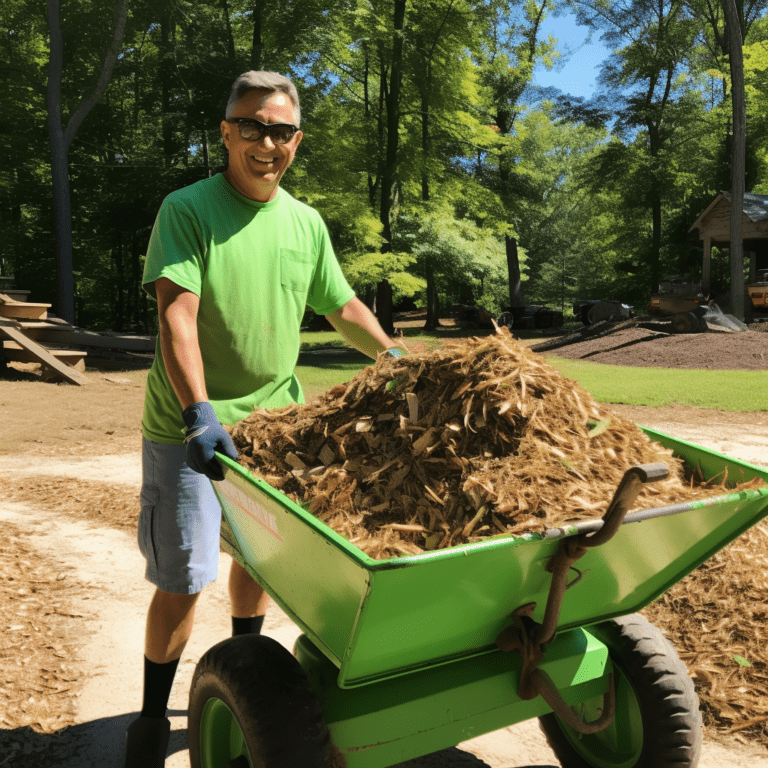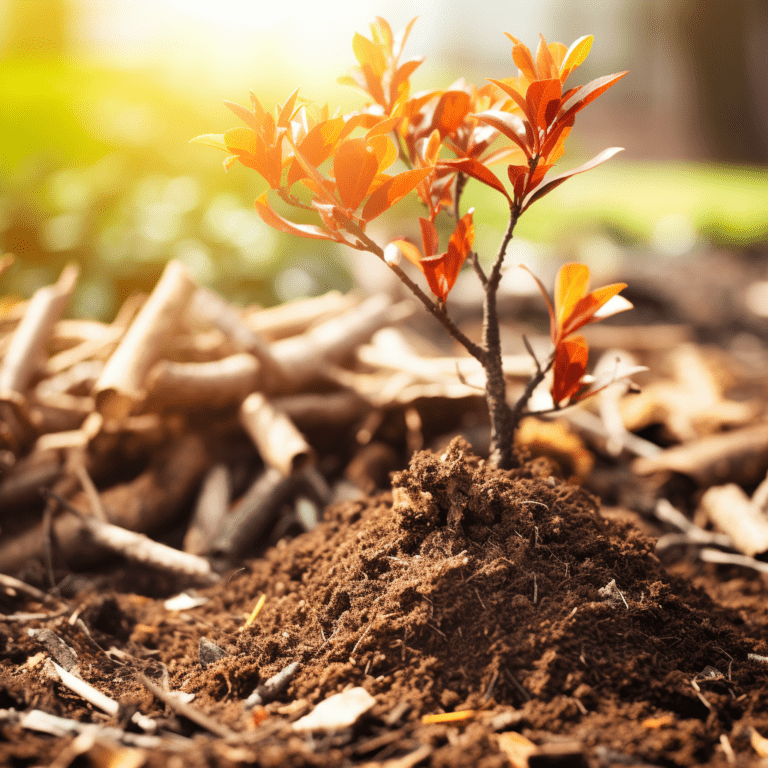Welcome to your comprehensive guide to fall mulching for healthy trees and shrubs in the beautiful Louisiana climate. As seasons shift and temperatures drop, it becomes crucial to grasp the key benefits of fall mulching in Louisiana’s unique climate and learn the best practices for nurturing your outdoor greenery. In this article, we’ll delve into the timing of mulching trees and shrubs in Louisiana, providing valuable insights for achieving optimal results.
Tree and shrub mulching in Louisiana offers numerous benefits to trees and shrubs, ensuring their health and longevity. It helps regulate soil temperature, conserves moisture, suppresses weed growth, prevents soil erosion, and enhances the visual appeal of your landscape. By providing a protective layer, mulch aids in insulating plant roots from extreme temperatures, keeping them warm during winter and cool during summer. Moreover, it improves soil structure while gradually breaking down and enriching the soil with vital nutrients.
Clean the area around the base of your plants, removing any debris and weeds.
It’s perfectly ok to leave some of the old mulch that has already started to decompose!
Aim for a depth of 2-4 inches.
Easily measure by sticking your index finger through the mulch to the top of the dirt... your mulch should cover at least 2 knuckles.
A few inches away from the trunk is all that’s needed.
Water the area after mulching to help settle the mulch and ensure it establishes good contact with the soil to keep it in place.
Applying mulch correctly is essential for its effectiveness. Take these steps to properly mulch your trees and shrubs:
Timing is crucial when it comes to fall mulching. In Louisiana, it is best to mulch trees and shrubs in late fall, after the soil has cooled down but before freezing temperatures set in. This ensures that your plants have proper insulation for the colder months ahead. Aim for late October through early December to give your greenery the maximum benefit of mulching in preparation for winter. Mulch should be refreshed periodically to ensure its effectiveness. Consider these factors when deciding to refresh your mulch:










In the South, where our climate has its own set of rules, choosing the right mulch is critical for the health of your trees and gardens. Organic options like straw, leaves, wood chips, or bark are generally preferred, as they decompose and enrich the soil over time. It’s important to ensure your mulch is free from diseases, insects, and weed seeds to avoid any unwanted surprises.

Given the unique conditions of our Southern climate, mulching is not a one-time event; it’s an essential practice that we recommend undertaking at least twice a year. Organic mulches not only protect but also nurture the land they cover. However, it’s wise to consult with local arborists and landscaping experts to tailor your mulching practices to your specific regional needs and the preferences of your plants and trees.
If you are looking for answers for what kind of mulch for xyz plant, look no further than this guide below.
| Mulch Type | Suitable Plants | Benefits |
|---|---|---|
| Organic Mulches | Most Trees and Shrubs, Flower Beds | Enriches Soil, Suppresses Weeds, Moisture Retention |
| Pine Straw Mulch | Acid-Loving Plants (Azaleas, Blueberries) | Acidifies Soil, Moisture Retention, Weed Suppression |
| Shredded Hardwood Mulch | Versatile, Many Tree and Shrub Varieties | Moisture Retention, Weed Suppression, Neutral pH |
| Bark Chips | Versatile, Many Tree and Shrub Varieties | Moisture Retention, Weed Suppression, Neutral pH |
| Leaf Mulch | Most Plants, Especially in Woodland Gardens | Nutrient Enrichment, Weed Suppression, Soil Health |
| Wood Chips | Fruit Trees, Vegetable Gardens, Pathways | Moisture Retention, Weed Suppression, Nutrient Enrichment |
| Compost | Vegetable Gardens, Flower Beds, Soil Amendment | Nutrient-Rich, Soil Conditioning, Weed Suppression |
| Straw Mulch | Vegetable Gardens, Strawberry Beds | Insulation, Weed Suppression, Moisture Retention |
| Cocoa Mulch | Flower Beds, Especially Around Roses | Aesthetically Pleasing, Moisture Retention, Weed Suppression |
| Rubber Mulch | Playgrounds, Landscaping in Wet Areas | Shock Absorption, Weed Suppression, Low Maintenance |
The cumulative effects of fall mulching can significantly extend the lifespan of your trees. By promoting healthy growth, mitigating stress, and reducing the risk of disease and pest infestations, mulched trees have the potential to live longer and provide shade, beauty, and environmental benefits for many years.
| Tree Species | Soil Preference | Mulch Preference |
|---|---|---|
| Live Oak | Well-Drained, Sandy Loam, Acidic to Alkaline | Organic Mulches¹, Shredded Hardwood Mulch² |
| Southern Magnolia | Rich, Moist, Well-Drained, Acidic to Slightly Alkaline | Organic Mulches¹, Bark Mulch³ |
| Bald Cypress | Moist to Wet, Sandy, Acidic to Alkaline | Organic Mulches¹, Pine Straw Mulch⁴ |
| Red Maple | Moist, Loamy, Acidic | Organic Mulches¹, Pine Straw Mulch⁴ |
| Sweetgum | Moist, Well-Drained, Slightly Acidic to Slightly Alkaline | Organic Mulches¹, Pine Straw Mulch⁴, Shredded Hardwood Mulch² |
| American Holly | Well-Drained, Sandy, Slightly Acidic | Organic Mulches¹, Pine Straw Mulch⁴ |
| American Sycamore | Deep, Rich, Moist, Well-Drained, Acidic to Alkaline | Organic Mulches¹, Shredded Hardwood Mulch² |
| Eastern Redbud | Light, Rich, Moist, Well-Drained, Acidic to Alkaline | Organic Mulches¹, Shredded Hardwood Mulch², Bark Mulch³ |
| Pecan | Well-Drained, Rich in Organic Matter | Organic Mulches¹, Shredded Hardwood Mulch² |
| Loblolly Pine | Well-Drained, Acidic, Moist, Sandy, Clay | Organic Mulches¹, Pine Straw Mulch⁴ |
¹ Organic Mulches: Comprised of leaves, clippings, etc. ² Shredded Hardwood Mulch: Made from shredded hardwood trees, helps retain soil moisture and prevent weed growth. ³ Bark Mulch: Made from tree bark, provides good weed control and moisture retention. ⁴ Pine Straw Mulch: Made from pine needles, acidifies the soil as it decomposes, suitable for acid-loving plants.

Fall mulching isn’t just a short-term fix; it’s an investment in the long-term health and vitality of your trees. By creating a stable environment, mulching promotes root development, enhances nutrient absorption, and boosts overall tree vigor. Here, we explore the enduring advantages of regularly mulching your trees in the fall.
One of the key long-term benefits of fall mulching is the promotion of robust root systems. When trees are mulched, the consistent temperature and moisture levels in the soil encourage root growth. Over time, this results in a dense and well-established root network. Stronger roots provide stability and improve the tree’s ability to access water and nutrients, making it more resilient to environmental stresses.
Mulching enriches the soil over time as the organic mulch gradually decomposes. This decomposition process releases essential nutrients into the soil, creating a nutrient-rich environment around the tree’s root zone. As a result, trees can more effectively absorb these nutrients, leading to improved overall health and growth.
Regular fall mulching contributes to increased tree vigor. Trees that receive consistent care, including mulching, are better equipped to handle stressors such as pests, diseases, and adverse weather conditions. Their enhanced vitality allows them to withstand challenges and continue to flourish year after year.
Mulched trees develop a level of resilience that extends to various environmental stressors. Whether it’s extreme temperatures, drought, or heavy rainfall, trees that have been consistently mulched are better prepared to cope with these challenges. Their strong root systems and improved nutrient uptake provide a buffer against adverse conditions.
The cumulative effects of fall mulching can significantly extend the lifespan of your trees. By promoting healthy growth, mitigating stress, and reducing the risk of disease and pest infestations, mulched trees have the potential to live longer and provide shade, beauty, and environmental benefits for many years.
In conclusion, fall mulching is not just a seasonal task; it’s a practice that pays long-term dividends for the health and longevity of your trees. Robust root systems, enhanced nutrient uptake, increased vigor, resilience against environmental stressors, and a prolonged lifespan are all lasting benefits that result from the consistent care provided by fall mulching.
Fall mulching is more than a garden chore; it’s a vital practice for both your garden beds and towering trees. This seasonal ritual transcends mere landscaping; it honors the interconnectedness of all living things in your outdoor space. As autumn’s golden hues mark the calendar, seize the opportunity to not just safeguard but enrich the soil beneath your garden flora and towering trees, setting the stage for a vibrant rebirth come spring.
The advantages are universal—from soil insulation and moisture retention to erosion control and weed prevention. Whether it’s the flower beds that dazzle with seasonal color or the trees that provide shade and habitat, a well-mulched ground ensures resilience and health across your landscape. It’s akin to building a strong foundation for your home; a supportive base that allows every living thing in your garden to not just weather the winter, but to thrive beyond it.
So, whether you’re a DIY gardener or prefer the convenience of professional service, make fall mulching an annual tradition. Your trees, your garden, and even future generations of flora will thank you.